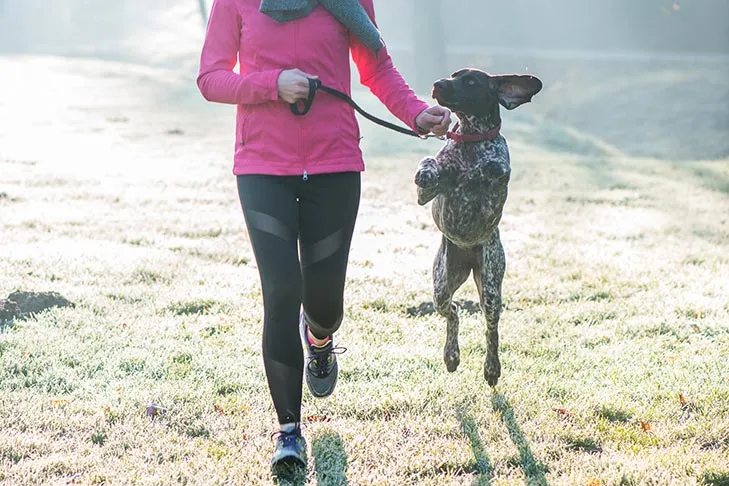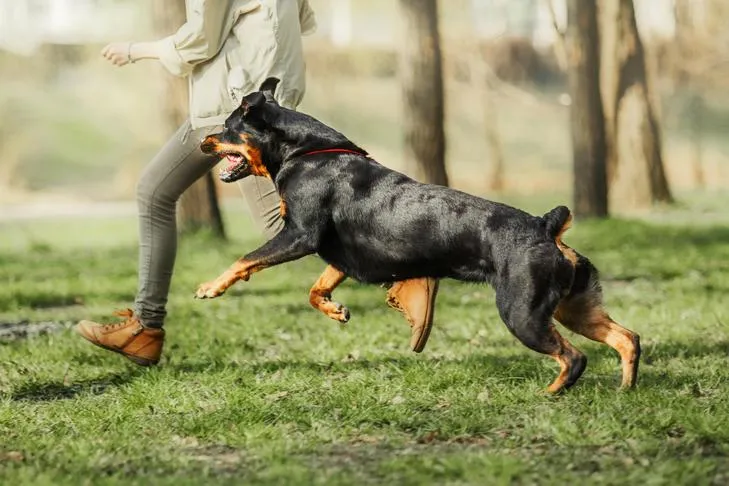Running with your canine companion is a fantastic way to bond and maintain fitness for both of you. It’s an excellent form of exercise that contributes significantly to canine fitness and overall well-being. Having a consistent running buddy can also be a powerful source of motivation, helping you stick to your fitness goals. If you’re wondering How To Train A Dog To Jog With You, this guide covers essential advice to ensure a safe and enjoyable experience for both of you. Before embarking on this exciting journey, understanding the fundamental steps and precautions is key to successfully train your dog to jog with you.
Assessing Your Dog’s Suitability and Age
Before you begin any training program, it’s crucial to ensure your dog is physically suited for running, especially for long-distance running. It’s generally not recommended to start running with puppies, as their bones and joints are still developing. For most breeds, it’s best to wait until your dog is around 1.5 years old to avoid potential injury.
Even within specific breeds, every dog possesses a unique personality, and some will naturally take to running more enthusiastically than others. Consider your dog’s temperament, research their breed’s typical energy levels and physical characteristics, and most importantly, take them to the veterinarian for a thorough physical checkup. This professional assessment will confirm that running is a safe and appropriate activity for your furry friend, ensuring they are healthy enough to embark on this training journey with you.
Mastering Loose-Leash Walking
Your dog must master loose-leash walking before you even consider picking up the pace. A dog that pulls on the leash can be frustrating during a leisurely walk but becomes genuinely dangerous when you’re moving at faster speeds. Remember that the outdoor environment is full of tempting rewards like squirrels, fascinating scents, and other distractions. To keep your dog focused and walking politely by your side, with the leash forming a relaxed ‘J’ shape, you need to be equally, if not more, rewarding. Utilize high-value treats, engaging toys, and enthusiastic praise to reinforce your dog every time they maintain a slack leash. If you’re struggling with this, focusing on how to stop a dog pulling on its lead is your first priority.
Keeping your dog consistently on one side of you is essential for safety once you start jogging together. If they run in front, lag behind, or weave from side to side, they could trip you or tangle your legs in the leash, leading to a fall for either of you. It doesn’t matter whether you choose the left or right side, but pick one and stick with it consistently. Start this training at a walking pace, always keeping reward placement in mind. Always deliver treats in the exact position you want to reinforce; for instance, if you want your dog on your left, only offer treats near your left leg. Once they’ve reliably mastered one side, you can teach them to be on the other side using a different verbal cue. Many runners find a hands-free dog leash beneficial for comfort and control during jogs.
 German Shorthaired Pointer running with a woman in the early morning.
German Shorthaired Pointer running with a woman in the early morning.
Introducing Speed Cues
With your dog now proficiently walking politely at your side, it’s time to incrementally increase your pace. When you’re out for a regular walk, it’s helpful to have a distinct cue, such as “let’s go,” that signals to your dog it’s time to move forward and maintain a walking speed. For jogging, a different, clear cue like “get running” or “move it” can be used to inform your dog that it’s time to pick up the pace and transition into a jog. The more precise information you provide your dog regarding your expectations, the more effectively and appropriately they will respond to your commands. This clarity is vital when you’re looking to get your dog to run with you.
To teach the running cue, begin by interspersing very short bursts of jogging or running into your regular walking routine. Simply give the chosen running cue immediately before you increase your speed, and then enthusiastically reward your dog with treats and praise when they quickly catch up and maintain position. Similarly, you can teach a cue such as “whoa” or “easy” to signal your dog to slow down or come to a stop, ensuring you have control over their speed. Consistency is key in establishing these important verbal commands.
 Rottweiler running in the park playing with its owner.
Rottweiler running in the park playing with its owner.
Building Endurance Gradually
Now that your dog understands how to stay by your side and match your pace, the next crucial step is to get your dog in shape and build their physical endurance. Just like humans, dogs need to develop their strength and stamina slowly and progressively to avoid injury and overexertion. Begin by incorporating small, manageable stretches of running into your daily walks. For instance, jog for one minute, then walk for five minutes, repeating this cycle.
On each subsequent walk, gradually increase the portion of your time spent running while decreasing the portion spent walking. This might mean jogging for two minutes, then walking for four, and so on. Over several weeks, following this consistent and incremental approach, your dog’s cardiovascular system and muscles will adapt, allowing them to comfortably run longer distances. Patience and observation are vital during this phase as you work to train your dog to jog safely and effectively alongside you.
Essential Tips for a Safe and Enjoyable Run
Your dog is finally trained and conditioned to be your ideal running with your dog companion. However, to ensure every outing is both safe and enjoyable, keep the following crucial tips in mind:
- Warm-up and Cool-down: Always begin your run with a several-minute walk to warm up your dog’s muscles and end with another few minutes of walking to cool them down properly.
- Weather Awareness: Be highly aware of environmental conditions. Dogs cannot regulate their body temperature as efficiently as humans and are more susceptible to heatstroke in hot and humid weather, or hypothermia in extreme cold.
- Hydration is Key: Always carry water for both yourself and your dog, offering them regular breaks to drink, especially on longer runs or warmer days.
- Frequent Breaks: Provide your dog with ample opportunities to rest, relieve themselves, and explore their surroundings briefly. These breaks are vital for their physical and mental well-being.
- Off-Leash Safety: Only allow your dog to run off-leash in areas where it is expressly safe and legal, and only if they possess a perfectly reliable recall amidst significant distractions.
- Observe Your Dog: Constantly monitor your dog for any signs that they’ve had enough. This might include excessive panting, lagging behind, seeking shade, or a change in gait. Dogs often try to please their owners and may continue running even when they are fatigued or uncomfortable, so it’s up to you to recognize these signals and prioritize their well-being.
Conditioning for Extreme Weather
Even the most dedicated runners sometimes face weather conditions that are simply too harsh—either too cold, too hot, or too wet—for a dog to run safely outdoors. While you might not be able to hit the trails together on these days, you can still maintain your dog’s physical conditioning with effective indoor exercises.
Depending on your dog’s size and energy level, a spirited game of fetch down a long hallway or multiple trips up and down a flight of carpeted stairs can effectively get their heart pumping and work their muscles. You can also create an engaging indoor obstacle course using household items like hula hoops, cardboard boxes, or cushions, encouraging them to jump, weave, and crawl. Additionally, many training facilities offer indoor agility classes, which are an excellent way to keep your dog mentally stimulated and physically active through running and jumping.
Many dogs can also be trained to safely use a treadmill. While some treadmills are designed specifically for dogs, a human treadmill can also work, provided the belt length is sufficient for your dog’s stride. Larger dogs will naturally require a longer belt. Although treadmill training can be an easy way to provide an indoor workout, it requires proper introduction and supervision. Research treadmill training techniques or consult with a professional dog trainer to ensure your dog learns to enjoy the machine and uses it safely. Critically, never tie your dog to the treadmill or leave them unattended while it’s in operation.
